Pterygium, recognized by a pinkish growth that emerges on the inner corner of the eye, can start out as an inconspicuous speck but has the potential to expand, eventually covering a portion of the cornea and potentially impairing your vision.
Unraveling the Impact of Pterygium
While in many instances it may not pose a serious health risk, pterygium can trigger uncomfortable sensations, often described as having a foreign object in the eye. If left unchecked, this growth may stretch across the pupil, resulting in obstructed or blurred vision, further complicating matters.
Identifying the Culprits: Causes of Pterygium
Pterygium growth can be attributed to various irritants such as prolonged exposure to sunlight, wind, and dust. Additionally, chronic dry eye syndrome is another potential risk factor that can facilitate the formation of pterygium.
Prevention Strategies
Shielding your eyes from potential harm is the most straightforward strategy to prevent the development of a pterygium. This can be achieved by donning sunglasses when outdoors to guard against sunlight exposure, especially in environments with high UV radiation, and airborne irritants like dust and wind.
The use of eye drops can aid in maintaining ocular hygiene and lubrication, offering protection to the eye membrane against dryness, which is often a precipitating factor for pterygium.
Treatment Approaches
If the pterygium evolves to a bothersome stage, impairs your vision, or persistently recurs, it necessitates treatment typically through an in-office surgical procedure. The ideal first step would be a consultation with an ophthalmologist who can assess the growth’s size, identify any atypical features, and monitor its rate of growth.
Conjunctival Autograft: A Resilient Remedy
Given the propensity for pterygium to recur, Conjunctival Autograft surgery is often the go-to treatment option. This procedure not only aims at eliminating the pterygium but also significantly lowers the likelihood of its return. Furthermore, it delivers the best cosmetic outcome post-surgery, restoring the eye’s natural appearance.
Exploring the Amniotic Membrane Graft Technique
Another surgical alternative your ophthalmologist might consider is the Amniotic Membrane Graft technique. In this procedure, following the removal of the pterygium, a section of the amniotic membrane is stitched to the eye. This method provides an additional option to effectively treat persistent or large pterygia, ensuring your vision remains clear and your eyes healthy.
Final Thoughts
The journey through understanding pterygium teaches us how vital it is to prioritize our eye health. Equipped with knowledge about its causes, preventative measures, and treatments, we can feel more empowered and proactive in managing our visual well-being.
Pterygium, though often not life-threatening, can significantly impact the quality of life and vision if left unattended. Thus, it is crucial to keep a keen eye on any noticeable changes or discomfort in our eyes, as early detection often leads to more straightforward and effective management.
We encourage anyone who suspects they might be experiencing the symptoms of pterygium, or has observed a growth in their eyes, to promptly consult a trusted ophthalmologist. Don’t dismiss potential signs as trivial, as what might seem insignificant initially could be indicative of a condition that requires attention. Your vision is a priceless asset; it deserves the best care and preservation.
Remember, taking the first step to seek professional advice is crucial in the path to maintaining good eye health and clear vision. Your world is worth seeing clearly, so don’t delay taking action for your eyes’ best future.
